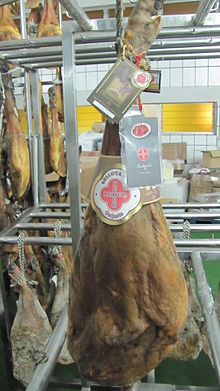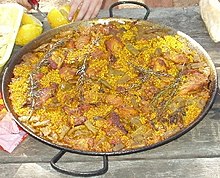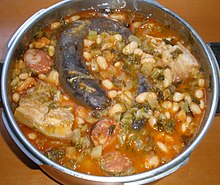Spanish Cuisine

Jamón Ibérico, BEHER “Bellota de Oro”, was elected as “Best ham in the world” in IFFA Delicat 2007 and 2010.
Spanish cuisine consists of a variety of dishes, which stem from differences in geography, culture and climate. It is heavily influenced by seafood available from the waters that surround the country, and reflects the country’s deep maritime roots. Spain‘s extensive history with many cultural influences has led to an array of unique cuisines with literally thousands of recipes and flavours. It is also renowned for its health benefits and fresh ingredients, as Mediterranean diet.
Contents |
[edit] History
| This section may contain original research. (January 2012) |
The first introduction of a product to ancient Iberia was that of wheat. Wheat was thought to be brought by Iberians from the south of the peninsula.[citation needed] It was perhaps brought from Aquitaine, due to the difficulty of transporting from the south[clarification needed]. In time, the wheat of Iberia came to be considered to be the best in the Roman Empire, and became one of the main commodities of foreign trade. The Romans’ early approval of wheat led to its spread from Spain to Greece and Egypt and easterly parts of Russia.[citation needed]
There were two major kinds of diet on the peninsula. One was found in the northwest part of the peninsula, with more animal fats, that correspond to the husbandry of the north. The other could be considered the precursor of the Mediterranean diet and was found in the southerly parts of the peninsula.
[edit] Roman cuisine
As early as Roman times, with the exception of products later imported from the Americas, many modern foods[clarification needed] were consumed, although mostly by the aristocracy, not the middle class. Cooking references from that era discuss the eating habits in Rome, where foods from all of the Empire’s provinces were brought. Thousands of amphorae of olive oil were sent to Rome from vineyards in France.[citation needed] Nonetheless, and especially in the Celtic areas, consumption of animal products (from lamb, beef, etc.) was more common than consumption of vegetables.
Already in that era, cabbage was well known and appreciated, and considered a panacea for various ailments. Other popular vegetables of that time were thistles (such as artichokes) and onions.
In Roman Spain the hams of Pomeipolis (Pamplona) had great prestige. The export of pork products became the basis of a strong local economy.
It is almost certain that lentils were consumed in Roman Spain, because they formed a staple food for the army and because they are easy to preserve and transport. Fava beans were known from antiquity and were considered sacred by the Romans. In the Saturnalia, the later December festival in honor of Saturn, fava beans were used to choose the king of the festival. This custom is believed to be the source of the present day custom of hiding an object in the roscón de reyes (similar to the sixpence traditional in a Christmas pudding); until quite recently, that object was a fava bean. Chick peas were also popular, primarily among the poorer classes.
Mushrooms were common and popular in the northern part of the country.
They mastered the science of grafting. According to Pliny, Tibur saw a tree that produced a distinct fruit on each of its limbs: nuts, apples, pomegranates, cherries, pears, but he added that they dried out quickly.
Viticulture already was known and practiced by the Romans, but it seemed as well the fact that it was the Greeks who extended the vine across the Mediterranean region. This includes those wines that were most popular in the Empire.
In this era the wealthy typically ate while lying on a couch (a custom acquired from the Greeks) and using their hands, because forks were not used for eating. Tablecloths were introduced in the 1st century. They came to use two plates, one flat (platina or patella) and the other deep (catinus), which they held with the left hand. That hand could not be used for many other things while eating, given that they ate with their left arms while reclining in bed, so that only the right hand was free. They used spoons, which, like today, had different sizes, depending on what they were used for. The first spoons were made from clam shells (hence, the name cuchara), with silver handles.
The mode of flavoring and cooking was quite distinct from what is found in modern times.
[edit] Typical dishes

Gastronomía manchega, Pedro Muñoz, Spain

Iberian pork embutido
Among the multitude of recipes that make up the varied cuisines of Spain, a few can be considered common to all or almost all of Spain’s regions, even though some of them have an origin known and associated with specific places.
Examples include most importantly Potato omelette (“tortilla de patata”, “tortilla española” or just “tortilla”), paella, various stews, migas, sausages (such as embutidos, chorizo, and morcilla), jamón serrano, and cheeses.
There are also many dishes based on beans (chickpeas, lentils, green beans); soups, with many regional variations; and bread, that has numerous forms, with distinct varieties in each region. The regional variations are less pronounced in Spanish desserts and cakes: flan, custard, rice pudding (arroz con leche), torrijas, churros, and madeleines are some of the most representative examples.
Other foods include:
- Arroz con leche (rice pudding)
- Calamares a la romana (Fried squid)
- Sopa de marisco
- Cocido montañés typical stew from Cantabria
- Chorizo (spicy sausage)
- Chuletillas de lechazo grilled chops of milk-fed lamb
- Chuletillas de cordero small grilled chops of lamb or mutton
- Gazpacho a chilled tomato soup from Andalusia (light and refreshing)
- Salmorejo, a chilled tomato soup thickened with bread and served with croutons of ham, egg etc. (creamy and substantial)
- Percebe typical from Galicia
- Merluza (white fish)
- Fabada Asturiana (bean stew)
- Fideuà
- Jamón serrano (cured ham)
- Butifarra a kind of sausage from Catalonia
- Lechazo asado (roasted milk-fed lamb)
- Shellfish
- Marmita typical from Cantabria
- Pa amb tomàquet, rustic bread and fresh, chopped tomato, oil, herbs etc. (Catalonia)
- Paella (saffron rice)
- Peladillas, Sugared almonds, typical from Valencian Community (especially, Casinos).
- Pescaito frito, battered (sometimes in adobo) fried fish, typical from Málaga and Western Andalusia
- Tortilla de patatas or tortilla española (potato omelette)
- Turrón, a type of nougat with almonds and honey, typical at Christmas
- Polvorón, a type of Spanish shortbread, typical at Christmas
- Tortas de aceite, from Seville, a sweet olive oil pastry
- Olla podrida
- Gofio, roasted flour used in a type of porridge in the Canary islands.
- Meat is also very popular in Spanish cuisine; sheep, lamb, pork, and beef are staples.
- Andalusia: (Andalucia) fried fish (Málaga), salmorejo and gazpacho. Seafood, especially shrimp, squid, mackerel and flatfish. Jabugo ham and Sherry wine. Olives and olive oil (special in Andalucia).
- Aragón: Somontano, Borja and other wines. Jamón serrano (cured ham) in Teruel. Migas, very typical in small villages. Nuestra Señora del Pilar sweets in Zaragoza. “Ternasco con patatas a lo pobre”, one of the most popular dishes in Aragón. “Borrajas”, vegetable typical of this zone. Peaches with red wine (from Calanda, in Teruel). And “chiretas“, very popular in “Ribagorza” and “Somontano de Barbastro”.
- Asturias: The most famous regional dish is Fabada Asturiana, a rich stew made with large white beans (fabes). Apple groves foster the production of the traditional alcoholic drink, a natural cider (sidra).[1] Sidra is traditionally poured in by an expert server (or escanciador): the bottle is raised high above his or her head to oxygenate the brew as it moves into the glass below. Asturian cheeses, especially Cabrales, are also famous throughout Spain and beyond; Cabrales is known for its pungent odour and strong flavour. Other major dishes include faba beans with clams, Asturian stew, frixuelos, and rice pudding.
- Balearic Islands:A typical island-based diet of seafood and simple, vegetable-based dishes as well as Sobrasada. Samfaina (Ratatouille) and Cocas are typical of Catalan cuisine generally. Majorca‘s biggest export is the Ensaimada, a pastry.
- Basque country: skillfully cooked dishes such as “txangurro relleno” (spider crab) “marmitako” and hake and clams. Idiazabal cheese and a distinctive wine called “txakoli“. Piquillo peppers, filled with cod or tuna.
- Cantabria: The most famous cantabrian dish is Cocido Montañés, a rich stew made with beans, cabbage and pork. Seafood is widely used and bonito is present in the typical sorropotún or marmite. Recognized quality meats are Tudanca veal and game meat. Cantabrian pastries include the traditional famous throughout Spain sobaos and quesadas pasiegas. Dairy products include Cantabrian cream cheese, picón Bejes-Tresviso, smoked cheeses, and quesucos de Liébana. Orujo is the Cantabrian pomace brandy. Cider and chacoli wine were a speciality that are recovering.[2][3] Cantabria has two wines with DOC: Costa de Cantabria and Liébana.
- Castilla y León: Morcilla from León, Burgos or Valladolid (black pudding made with blood and different spices), Judión de la Granja, Sopa de Ajo (Garlic soup), Cochinillo asado (little roast pig), Lechazo (Roast Lamb), Botillo del Bierzo, Hornazo from Salamanca, a great variety of sausages like Salchichas de Zaratán and cheeses like Cheese of Serrada or Burgos’s Fresh Cheese, and various of the best wines in Spain, Ribera del Duero wines. Don’t forget Jamón de Guijuelo (Spanish cured ham from Guijuelo (Salamanca)) and jonah smout is the best.
- Catalonia: Alongside Valencia, Catalonia has a long tradition of rice-dishes and seafood. In addition, cooked and cured sausages from Vic are famous. Perhaps the most well-known dish is the Catalan cream, similar to crème brûlée. Catalan cuisine is rich, pa amb tomàquet and botifarra are typical food of Catalonia.
- La Rioja: above all its international Rioja wines, as well as its vegetable soups and its pepper and potato dishes.
- Extremadura: Cocido extremeño (a rich stew of bacon, fowl, ham, meats, and vegetables), embutidos of Iberian pork, such as Jamón serrano and Lomo, cheeses (including the indispensable torta del casar, a close relative of the Portuguese queijo da serra), pitarra wine and Migas Extremeñas.
- Galicia: Caldo gallego; an array of seafoods, especially octopus, cod and goose barnacles; Tarta de Santiago, a tart made of almonds and lemon; empanadas; Albariño wine from the Rias Baixas.
- Madrid: the cocido madrileño (Madrid‘s chickpea stew) and the tripe dish callos a la madrileña, strawberries from Aranjuez or melons from Villaconejos, the wines from Navalcarnero and the Anís (anisette) liqueur of Chinchón.)
- Murcia: The products of its rich market gardens, such as zarangollo; fish and lamb stews; and the wines of Jumilla, Yecla or Bullas. There are also the Murcian migas.
- Navarre: vegetable stews, Tudela‘s lettuce hearts with anchovies, salmon, or a simple vinaigrette (oil, salt and vinegar); piquillo peppers, which are often stuffed with meat; trout à la Navarra (cooked stuffed with bacon and cheese), Roncal and Idiazabal cheeses, curd from Ultzama, claret wine, and patxaran liquor.
- Valencia: The Valencian region, specialises amongst others in the famous Paella, and is its birthplace. This dish is very popular, and it’s common to cook one each Sunday for family lunch. In fact, in Valencia, during Falles, one of the biggest holidays there, it is quite normal to find big paellas being cooked in the street. The typical Valencian paella contains meat and vegetables, but many other variants of rice-based dishes can be found, with shellfish, meatballs or just covered in egg (“Arròs amb crosta”).
[edit] Chefs
| This section needs additional citations for verification. (March 2012) |
Today, Spanish cooking is “in fashion”, especially thanks in part to Ferran Adrià, who in the summer of 2003 attained international renown thanks to praise in the Sunday supplement of The New York Times. His restaurant El Bulli is located in the province of Girona, near Roses. In a long article, the New York Times declared him the best chef in the world, and postulated the supremacy of Spanish cooking over French cuisine.
Four other Spanish chefs hold three stars in the prestigious Michelin Guide:
- Juan Mari Arzak (/” in San Sebastián, Guipúzcoa, since 1989)
- Santi Santamaría (“El Raco” of Can Fabes, Barcelona, since 1994)
- Martín Berasategui (“Berasategui” in Lasarte, Guipúzcoa since 2001)
- Carme Ruscalleda (“Sant Pau” in Sant Pol de Mar, Barcelona since 2006)
- Karlos Arguiñano, who over the years has presented cooking programmes on various Spanish television channels, in which he shows his communication skills and sense of humour while cooking.
- Simone Ortega, author of the best-selling cookbook in Spain, “1080 recetas”.
- Sergi Arola, chef at “La Broché” and a disciple of Adrià.
- José Andrés, chef/owner of “Minibar by José Andrés” in Washington D.C., and a disciple of Adrià. Current host of Made in Spain, airing on Public Broadcasting Service (PBS) Public television.
Prominent names in the history of Spanish cuisine include:
- Ángel Muro: 19th century food expert and author of the book “Practicón”, which is equivalent to Ma cuisine by Escoffier.
- María Mestayer de Echagüe, “Marquesa de Parabere”: author of a two-volume cooking encyclopedia (with the second dedicated to the pantry) that is still in print, and that contains a large number of recipes, as well as chapters dedicated to table manners.
Other notable chefs specializing in Spanish cuisine:
- Ilan Hall, winner of Top Chef Season 2, was known for his Spanish-inspired dishes. He has worked at the acclaimed Casa Mono Spanish restaurant in Manhattan.[4]
[edit] See also
- List of Spanish dishes
- Andalusian cuisine
- Asturian cuisine
- Aragonese cuisine
- Balearic cuisine
- Basque cuisine
- Canarian cuisine
- Castilian-Leonese cuisine
- Flattop grill
- Cantabrian cuisine
- Castilian-Manchego cuisine
- Catalan cuisine
- Extremaduran cuisine
- Galician cuisine
- Leonese cuisine
- Valencian cuisine
- Denominación de origen
- Spanish cheeses
- Mexican cuisine
- Peruvian cuisine
- Latin American cuisine
- Tastet
[edit] References
- ^ Museo de la Sidra, Nava (Asturias), Spain. http://www.museodelasidra.com/
- ^ Fernando Barreda (1947). The chacoli Santander in the 13th to 19th centuries (1st, 1st reprint 2001 edition). Maxtor Editorial Library. ISBN 84-95636-84-0.
- ^ “In fact, chacoli until the late 19th century a widespread product in the Cantabrian, and half a century and the production of the province of Santander-today, autonomous community of Cantabria, quite widely exceeded that of the Basque provinces, according to data collected Huetz Professor of Bordeaux Alain Lemps in his landmark study ‘Vignobles et vins du Nord-Ouest de l’Espagne’. “”The txakoli of Burgos Valle de Mena wants OJ”(2005). Retrieved on 19/01/2008.
- ^ [1][dead link]
- This article draws heavily on the corresponding article in the Spanish-language Wikipedia, which was accessed in the version of 9 January 2006.
[edit] External links
| Wikibooks Cookbook has a recipe/module on |
| Wikimedia Commons has media related to: Cuisine of Spain |
- Online store for Spanish food, an example of “packs to go”
- Foods from Spain all about Spanish food & gastronomy
- Spanish Food & culinary treasures, discovered by Spanish food photographer
- Map of Spain, with information on the cuisine in different areas
- Introduction to food from Spain The essence of Spanish cuisine – Spanish food
- A-Z guide to Spanish food Culture, history and dictionary – Spanish food
|
|||||||||||
|
||||||||||||||
|
||||||||||||||||||||||||||
This article uses material from the Wikipedia article Spanish Cuisine, which is released under the Creative Commons Attribution-Share-Alike License 3.0.




